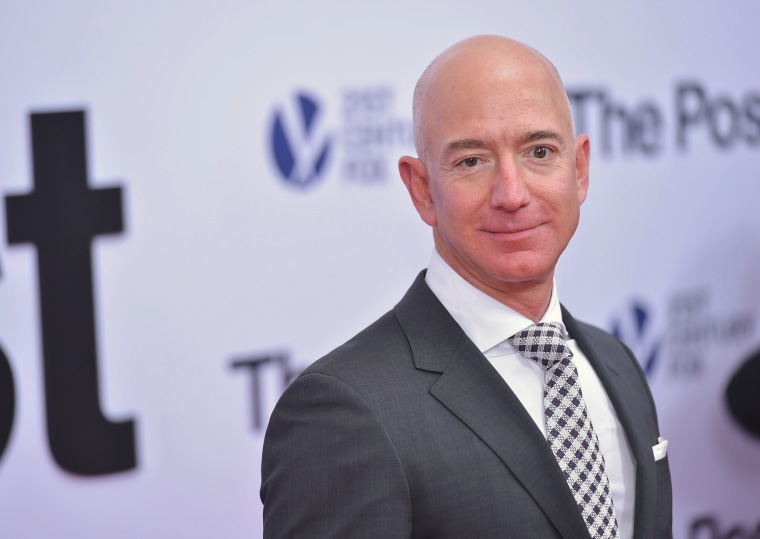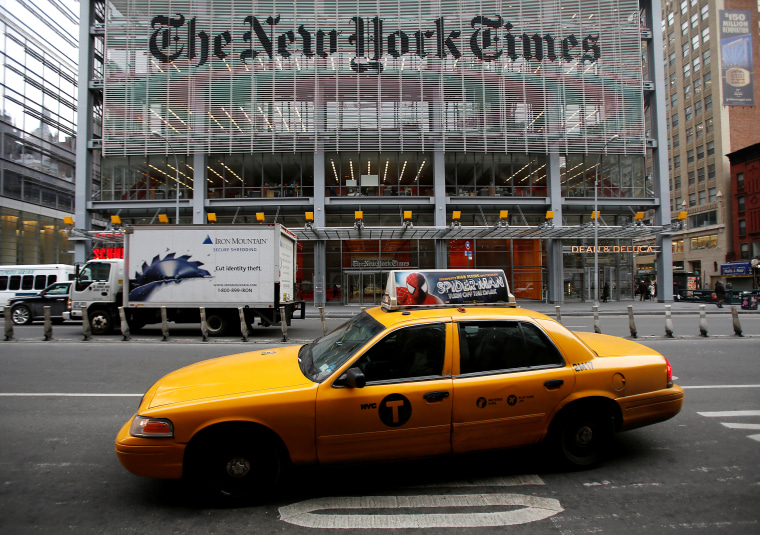In “The Post,” Steven Spielberg’s newest movie, the fiercely competitive editors of The Washington Post battle against government efforts to prevent follow-up stories to The New York Times’ publication of the Pentagon Papers.
The movie is a huge publicity coup for The Post, but also a reminder that in many ways, the newspaper is still playing catch-up to The Times.
The Post had a good year, winning a Pulitzer Prize in April for David A. Fahrenthold’s reporting on Donald Trump’s opaque charitable giving. It has broken numerous stories on the Trump administration, the Russia investigation, and the sex harassment scandals. In November, the newspaper shifted the axis of the Alabama Senate race, revealing that the Republican candidate, Roy Moore, initiated a sexual encounter with a 14 year old when he was in his thirties. Moore lost in part because of the revelations.

Under its free-spending owner, Jeff Bezos, the CEO of Amazon, The Post has hired more than 100 new reporters and editors, and rebuilt its presence outside of Washington. It has become a much bigger part of the digital conversation on public affairs.
Nikki Usher, an associate professor at George Washington University, predicted that 2018 will be the year of The Washington Post.
“You do see people who are opposed to the Trump administration making The Post now their first read,” she said. “Maybe The Post is optimizing for anger a little bit better.”
But in the transition to a digital subscription business — vital given the sharp falloff in newspaper print circulation, and a big head start by The Times — The Post still has work to do. Fred Ryan, the publisher of The Washington Post, said in September that the newspaper had crossed one million paid digital-only subscribers this year, doubling the number since Jan. 1. That put The Post among the top three newspapers in the country, just behind the Wall Street Journal’s 1.27 million digital subscriptions through June.
But that’s still far behind The Times, which has 2.5 million digital-only subscribers, and a further one million print subscribers.

Bezos pays intimate attention to the newspaper he bought from the Graham family for $250 million in 2013. In June, attending the “Future of Newspapers” conference in Turin, Italy, he told attendees: “This is not a philanthropic endeavor. For me, I really believe, a healthy newspaper that has an independent newsroom should be self-sustaining. And I think it’s achievable, And we’ve achieved it.”
While the notoriously numbers-shy Bezos hasn’t shared how profitable his company is, there have been a few hints. In May, The Post’s chief revenue officer, Jed Hartmantold The Times that digital ad revenue was in the “solid nine figures,” or over $100 million, and that 2017 would be the company’s third year of double-digit revenue growth. The newspaper doesn’t share overall revenue but has said it was profitable in 2016.
But The Times, which is publicly traded, booked some $154 million in digital advertising through the first nine months of the year, a 17.5 percent increase over the same period a year ago, while print ad revenue fell 16 percent to $221.8 million.
While The Times is miles ahead in the fight to sign digital subscribers, The Post is battling back with an old-fashioned price war. The Post offers Amazon Prime subscribers free access for six months and then charges $3.99 per month; everyone else can pay $8.30 per month for a long-term commitment.
The New York Times sells itself as a premium product, charging between $8 and $15 a month, depending on discounts, and isn’t perturbed by the discounting. Clay Fisher, the paper’s newly appointed head of consumer revenue, said that 2017 has been a record-breaking year for new subscribers.
“We feel like we have the highest quality product,” said Fisher. “The Post is more of a value offering. They’ve really been aggressive on price, but they’re also trying to build their base.”
Both papers are also competing for an international audience that wants to know what’s happening in American politics. The Times says that 14 percent of its digital subscription base, or about 350,000 subscribers, is international. The Washington Post launched a newsletter, entitled “Today's WorldView,” that has helped add overseas subscribers too.

Come January, The New York Times will have a new publisher, Arthur Gregg Sulzberger, working in tandem with the Times Company’s chief executive, Mark Thompson. Sulzberger, 37, who takes over from his father, Arthur Ochs Sulzberger Jr., is familiar with the challenges of turning a Titanic-sized newspaper into a nimble digital media operation.
In 2014, he helped write a report that criticized the paper’s digital progress, noting that online news aggregators like the Huffington Post and Flipboard often got more traffic from the paper’s journalism than the paper itself.
"Not only is the audience on our website shrinking but our audience on our smartphone apps has dipped, an extremely worrying sign on a growing platform,” the report said. “The urgency is only growing because digital media is getting more crowded, better funded and far more innovative.”
Much has changed since then. Thanks to a strict pay-wall and some stellar journalism, the paper’s digital future is not quite as endangered. The Times also had a momentous year, winning three Pulitzers in April, breaking the first of the big sex harassment stories, on producer Harvey Weinstein, as well as pioneering coverage of former FBI chief James Comey’s memos on Trump and Michael Flynn.
Again The Times remains ahead of its rival when it comes to its digital audience, but The Post has been closing the gap. In October 2013, the Washington Post Company tallied just 25.8 million visitors to its desktop properties with The New York Times drawing 34 million, according to ComScore. Two years later, Digiday reported that The Post beat The Times for the first time, drawing 66.9 million readers compared to The Times’ 65.8 million.
By October 2017, The New York Times moved ahead with a total digital audience of 93.5 million per month, compared to The Post’s 88.9 million unique visitors. In page views, The Times is also still ahead with 1.2 billion digital page views, compared to 821 million for The Post, according to the Washington Post PR blog.

Craig Huber, a media analyst at Huber Research, based in Connecticut, said the Times’ growth in building digital subscribers is “the main part of the investment story as they build up their base of digital payers.” It would be hard to argue the Times hasn’t excelled at this.
The company now sees its competition as Netflix or Spotify in the quest to persuade readers that they should pay for news and information, as they do for entertainment. The newspaper’s goal is to hit $800 million in digital revenue by 2020. Recode recently reported that digital revenue could hit $579 million in 2017, suggesting that goal could be achieved.
Huber notes that the upcoming challenge for both newspapers is a lack of growth in digital advertising.
“Digital advertising at The New York Times, like virtually every other company outside of Google and Facebook, has hit a wall in the second half of 2017,” he said. “It is going to be flat-ish year over year in the fourth quarter, after growing 11 percent in the third quarter and 22 percent in the second quarter.”
As recently as 2004, advertisers were spending close to $50 billion on print. In 2016 it was $18 billion, according to an analysis by the Pew Research Center.
Not all competition is measured in dollars and cents, however.
“For many people, The New York Times was the paper of record,” said Robert Thompson, director and professor at the Bleier Center for Television and Popular Culture at Syracuse University. “But The Washington Post happened to be at the center of the greatest story ever told in the history of newspapers.”
He was referring to Watergate and prominence gained by Bob Woodward and Carl Bernstein after their book, “All the President’s Men,” and the subsequent movie.

The Times had a previous Nixon-era scoop with the publication of the Pentagon Papers, and many at the paper are rankled that the movie on the subject is about Katharine Graham and the Post, and not their institution.
The Times issued a not-terribly-subtle reminder of its scoop by reprinting the Pentagon Papers in book form, and then releasing a press statement and a full-page ad noting that the papers were first released by The Times. The ad (and the book cover) cheekily quotes The Washington Post as calling the scoop “the most significant leaks of classified material in American history.”
Bezos, who could end up at the Academy Awards if Spielberg’s “The Post” wins a nomination, is clearly wary of too much self congratulation. Speaking at the celebrity-filled ribbon cutting ceremony after his acquisition of the Washington Post in 2013, he said: “I’m a huge fan of leaning in to the future...Too much glamorizing of the past would certainly lead to paralysis.”